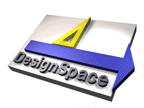 DesignSpace
DesignSpace
 DesignSpace
DesignSpace
This page is under construction.
Please excuse the dust and debris.
Then came the Graphical User Interface (GUI,"goohy") to give designers "direct manipulation" and a toolbox of icons that could be selected and applied to specific objects in constrained ways. The parameters to the tool, and thus the task, could be adjusted through a dialog box, alleviating syntax memorization. GUI's were sometimes frustrating to veterans of the command interface, since all the picking, clicking, and switching input devices (keyboard and mouse) sometimes slowed them down. To novices, GUI's were a great step forward.
At this point in its history, CAD would have been in good shape to continue as the prime provision of 2D drawing, design, database, and documentation tools for describing real-world artifacts with annotated orthographic viewsets. But 2D CAD was missing the entire point by being a model of paper which is itself a model of the volumetric objects which were under design. Why should the model in the computer not describe the object of the design instead of a piece of paper?
Today CAD is struggling somewhere in a transition between its roots (a paper, scale, and rule replacement) and its future (total design simulation with a full spatial model). While much of the research is being put into increasing the sophistication of the tools, such as via artificial intelligence techniques such as agents, the biggest battles are being fought over the paradigm shift in the design process product (formerly drawing and specification documents) and the user interface to access the spatial model within the constraints of a standard computer interface. DesignSpace proposes first that the standard computer interface need not be a constraint, and second that maybe the standard computer interface should change.
_________________________________________chapin@cdr.stanford.edu


______